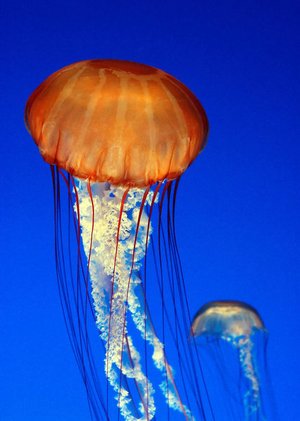Inspired by an excruciatingly painful jellyfish sting, I decided to do my research on the little pest and was left amazed.
1) There are about 200 species of true jellyfishes.
2) Jellyfish belong to the Phylum Cnidaria. The same group of animals coral belongs to. They do not have gills or lungs. They aren’t fish nor mammals. That’s why many people prefer to call them sea-jellies instead of jellyfish.
3) Sizes in jellyfish are highly variable. They can be small as a grape or like the largest known jellyfish (Lion’s Mane Jellyfish) that can reach a diameter of 2.5 m / 8ft and its tentacles can grow to be half the length of a football field.
4) In countries like China, Japan, and Korea it is considered a delicacy to eat Jellyfish. Jellyfish must immediately be dried to be eaten, jellyfish spoil if not dried in a matter of hours, creating a large jellyfish drying market. Jellyfish on its own is tasteless soy sauce or vinegar are added to create taste. Some species of jellyfish contain a lot of protein, many are trying to use this fact to deal with the global malnutrition problem.
5) Each jellyfish contains a biologically multifunctional opening, which acts as mouth, anus and vagina. Jellyfish take food through this mouth and remove the body’s waste through it. The male also releases his sperm into the water which travels into the jellyfish’s mouth to fertilize the female jellyfish’s ova.
6) Jellyfish are found in every ocean from deep levels to the surface.
7) Jellyfish are thought to be one of the oldest living creatures on earth. Existing for more than 650 million years, existing before dinosaurs and obviously surviving longer.
8) Jellyfish have no blood, brain, or nervous system. They have primitive senses like eyes that allow them to detect light from dark, a neural net, and chemosensory pits that let them know if prey is near by.
9) 95% of a jellyfish is made of water, water supports their body because the lack of an outer shell and skeleton. However, this makes them very delicate. If a jellyfish is removed from water it collapses from evaporation, leaving nothing more than a circle of film.
10) Jellyfish move through the action of muscular jet propulsion (taking water in and then releasing it to move forward). The other way is by drifting with the current.
11) Jellyfish produce both sexually and asexually, in the jellyfish’s polyp stage, where its tentacles are faced upward while their bodies are to the floor the jellyfish reproduces asexually, while when it is in its mature medusa stage (the one us beach goers are more acquainted with) the jellyfish reproduces sexually.
12) The box jellyfish (sea wasp) is considered the most venomous animal on earth, killing more people each year more than any other marine creature, that includes sharks.
13) Due to global warming their is a decrease in rainfall increasing the ocean’s salinity. This increase in salinity has aided in a strong increase in the jellyfish population that thrives in salt water.
14) Jellyfish are a big annoyance for lots of ships who have to deal with swarms of billions of jellyfish that clog up the ship’s water inlets.
15) The defense mechanism for jellyfish are the thousands of nematocytes located on its tentacles, mouth and feeding arms. Each nematocyte contains chemosensitive hairs and a venomous sac, the hairs detect the presence of prey and the venom is then released to immobolize the prey. The nematocytes are what are responsible for the painful stings me and many beach goers experience.






